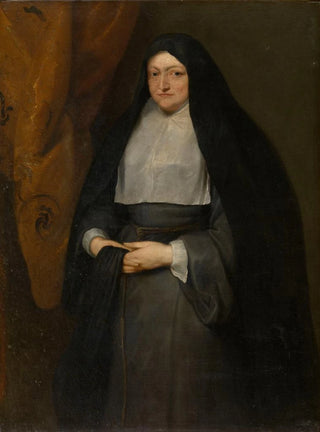Art print | Infante Isabelle Clara Eugenia - Antoine van Dyck


View from behind

Frame (optional)
The artwork "Infante Isabelle Clara Eugenia" by Antoine van Dyck stands as a true ode to beauty and delicacy. This painting, which captures the very essence of 17th-century aristocracy, immerses us in a universe where refinement and sophistication reign supreme. Through the gaze of the infante, the viewer is invited to explore the subtleties of the Spanish court, while marveling at the undeniable talent of the artist. The art print of this iconic piece allows for an appreciation of van Dyck's virtuosity, while offering a window into a past where art and nobility were intimately intertwined.
Style and uniqueness of the work
The uniqueness of "Infante Isabelle Clara Eugenia" lies in how van Dyck manages to blend realism and idealization. Every detail, from the sumptuous drapery of the dress to the gentle, thoughtful expression of the infante, demonstrates exceptional craftsmanship. The light, skillfully orchestrated, highlights the delicate features of the face and the texture of the fabrics, creating an atmosphere that is both intimate and majestic. The colors, carefully chosen, evoke a rich and harmonious palette, reinforcing the idea of a nobility that is both accessible and distant. This painting does not merely depict a historical figure; it captures an essence, that of an era when art was a reflection of society.
The artist and his influence
Antoine van Dyck, a major figure of Flemish Baroque, left his mark through an innovative approach to portraiture. A pupil of Rubens, he developed a style that is uniquely his own, characterized by refined elegance and meticulous attention to detail. His influence extends far beyond his time, inspiring many artists across the centuries. By choosing to paint members of the nobility and royalty, van Dyck not only immortalized their features but also helped shape the image of European aristocracy. His work "Infante Isabelle Clara Eugenia" is a perfect example of this ability to combine art and power, creating portraits that transcend

Matte finish

View from behind

Frame (optional)
The artwork "Infante Isabelle Clara Eugenia" by Antoine van Dyck stands as a true ode to beauty and delicacy. This painting, which captures the very essence of 17th-century aristocracy, immerses us in a universe where refinement and sophistication reign supreme. Through the gaze of the infante, the viewer is invited to explore the subtleties of the Spanish court, while marveling at the undeniable talent of the artist. The art print of this iconic piece allows for an appreciation of van Dyck's virtuosity, while offering a window into a past where art and nobility were intimately intertwined.
Style and uniqueness of the work
The uniqueness of "Infante Isabelle Clara Eugenia" lies in how van Dyck manages to blend realism and idealization. Every detail, from the sumptuous drapery of the dress to the gentle, thoughtful expression of the infante, demonstrates exceptional craftsmanship. The light, skillfully orchestrated, highlights the delicate features of the face and the texture of the fabrics, creating an atmosphere that is both intimate and majestic. The colors, carefully chosen, evoke a rich and harmonious palette, reinforcing the idea of a nobility that is both accessible and distant. This painting does not merely depict a historical figure; it captures an essence, that of an era when art was a reflection of society.
The artist and his influence
Antoine van Dyck, a major figure of Flemish Baroque, left his mark through an innovative approach to portraiture. A pupil of Rubens, he developed a style that is uniquely his own, characterized by refined elegance and meticulous attention to detail. His influence extends far beyond his time, inspiring many artists across the centuries. By choosing to paint members of the nobility and royalty, van Dyck not only immortalized their features but also helped shape the image of European aristocracy. His work "Infante Isabelle Clara Eugenia" is a perfect example of this ability to combine art and power, creating portraits that transcend






